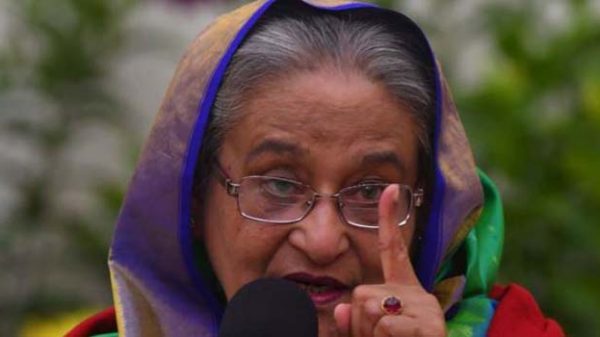Dharla likely to meet Teesta’s fate

The Dharla and a few other rivers flowing from India into Bangladesh are set to meet the fate of the Teesta following the West Bengal government’s arbitrary decision to withdraw water from the Jaldhaka River in India, river experts said.
The Jaldhaka River takes up the name Dharla inside Bangladesh, river experts said, adding that lifting water from it means less flow in the Dharla, which will affect nature, life, and the economy in many ways.
In early March, the West Bengal irrigation department acquired 1,000 acres for constructing two new canals for withdrawing water from the Teesta and the Jaldhaka rivers, reported Indian media.
The Teesta, once a mighty river flowing from the Himalayas, became a mere stream in Bangladesh, often broken by vast stretches of sandy riverbeds, because India arbitrarily withdrew almost the entire flow of the river at the Gajaldoba Barrage, particularly since 2012, river experts said.
Over the past two decades, revealed an official account, 90 per cent of fish species in the Teesta went extinct, destroying biodiversity and river-dependent livelihoods.
‘The Jaldhaka accounts for 90 per cent of the water flow in the Dharla,’ M Inamul Haque, former chief engineer of the Bangladesh Water Development Board, told New Age.
Originating in Bhutan, the Jaldhaka River enters the northern Jalpaiguri district of West Bengal and flows about 141km before entering Bangladesh, according to a 2020 study published in the Bangladesh Geoscience Journal.
The river enters Bangladesh from India in a northwest-southeast direction at Mogolhat union of Lalmonirhat and then, assuming the name Dharla, flows about 57 km before falling into the Jamuna River at Ulipur, Kurigram.
The Dharla River, with an average width of 1,200 metres, travels through Lalmonirhat and Kurigram districts.
Dharla, together with the Teesta, Dudhkumar, Jinjiram, Banshi, Dhaleshwari, and Sitalakhya rivers, constitute part of the Brahmaputra catchment measuring 39,401 square km, according to Inam.
‘Withdrawal of water from the Jaldhaka will affect the Brahmaputra water supply chain,’ he said.
The canal that West Bengal plans to use to withdraw water from Jaldhaka, along with the Teesta, would run 32 kms.
The canal will cross over many other trans-boundary rivers that are not officially recognised but flow from India into Bangladesh between the Teesta and the Jaldhaka rivers, drawing water from all these rivers as well, said professor Tuhin Wadud, director of Riverine People, a knowledge-based civil society movement to restore and conserve rivers.
‘The plan is to deny Bangladesh any water,’ said Tuhin, naming three of the unrecognised trans-boundary rivers as Saniyajan, Ratnai, and Maldaha.
Tuhin said that many such trans-boundary rivers are flowing between the Teesta and the Jaldhaka.
The Teesta does not have much flow to supply water to the new canal, Tuhin said, adding that the main intention of building the fresh canal is to lift water from the unrecognised trans-boundary rivers.
‘Jaldhaka water withdrawal will not affect agriculture alone,’ Tuhin said, ‘Aquatic lives and river-dependent livelihoods will be destroyed.’
Officially, there are 57 trans-boundary rivers between India and Bangladesh. Bangladesh hosts 1,216 rivers, according to the book Rivers of Bangladesh, authored by Inam.
Experts say that rivers are crucial to the existence of Bangladesh, a landmass that rose out of the sea by the deposition of sediments carried along by rivers over centuries.
The existence of Bangladesh and its residents is directly dependent on the survival of rivers, big or small, according to river experts.
Reduced water flow in the rivers means saltwater intrusion, increased siltation, and erosion, explained river experts.
They pointed out that Teesta is not the only example of the disastrous impacts inflicted by India’s arbitrary water withdrawal.
After India began withdrawing water from the Farakkah barrage in 1975, the Gorai River flow in Bangladesh drastically dropped, and many other rivers died, leading to saltwater intrusion along the coast.
India also attempted to build the Tipaimukh dam in the Barak valley upstream of Meghna.
India also built dams in tributaries of the Teesta, built water reservoirs, and diverted flows from the Teesta to release the water into Mahananda—about 10 per cent of the Teesta flow is diverted to Mahananda, according to Indian media reports.
‘The water diverted from the Teesta to Mahananda is not even used. West Bengal does not need this water,’ said Inam.
Inam advised that the government should find out the base flow of trans-boundary rivers.
The geoscience journal, in its 2020 study, found the average discharge of Jaldhaka in Shimulbari to be 462 m3/s and the average discharge of Dharla in Kurigram station to be 628 m3/s. The river gauging stations are located at a distance of 30 km.
Bangladesh has long been demanding a treaty over sharing the Teesta’s water since 1952. Bangladesh has a water-sharing treaty for the Ganges River.
A Teesta treaty was almost reached in 2011 but was eventually put aside due to opposition from West Bengal chief minister, Mamata Banerjee, who said she needed water for irrigation.
Geological scientists reminded that the Dharla is a flashy river with a reputation for causing erosion, largely because of the backwater effect at its confluence with the Jamuna River, particularly during the monsoon.
‘Drop in the Dharla water level would immediately result in increased erosion,’ said a geoscientist seeking anonymity for he found speaking on the issue on record risky.
The Dharla is erosion-prone and in 1947 it completely washed the old site of Kurigram town.
The Dharla riparian area, with an average population density of over 1,000sq km, is like a lifeline in Kurigram, ranked in 2020 as the poorest region of Bangladesh, where environmental destruction is the last thing people want.
‘The environmental and economic impacts the withdrawal of Jaldhaka is going to have are many,’ said Tuhin.
‘Bangladesh should seek remedy under the international water convention and ask for environmental and economic compensations from India,’ he said.
‘If water withdrawal from the Jaldhaka cannot be resisted, India will not let any river flow into Bangladesh,’ he said.
Water resources state minister Zaheed Farooque could not be reached for comments despite several attempts.























Leave a Reply